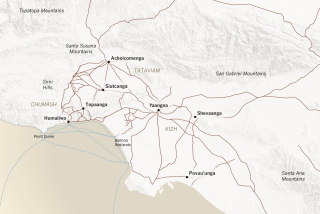Caretaker of Indian Relics Fights for Fee
Archeologist Nancy A. Whitney-Desautels felt elated last year when she uncovered the storied “Lost Village of Encino.” But today, the 36-year-old archeologist faces uncertainty as she tries to collect $400,000 she maintains is still owed her for excavation and analysis of 2 million Indian artifacts.
The village was first described in the writings of a missionary who accompanied Spanish explorer Gaspar de Portola on a 1769 expedition of the first white explorers in the San Fernando Valley. The ruins of the village had for years been the goal of searches by other archeologists.
During her eight-month excavation, Desautels unearthed stone and glass beads, tools, arrowheads and human and animal bones.
But money to preserve and catalogue the relics will not be coming from the Legislature, since a $975,000 bill proposed by state Sen. Alan Robbins (D-Van Nuys) has been scrapped. Desautels is negotiating for reimbursement with the development firm that hired her to conduct the excavation, First Financial Group Inc. of Encino.
“Obviously, I’m disappointed that money will not be forthcoming to continue work on the collection,” she said of the state appropriation.
Desautels asserts that First Financial, which hired her as a contractor early last year, is legally responsible for the costs she incurred while excavating an Indian cemetery and for the cost of preserving and analyzing the artifacts through late September, when she says First Financial issued a stop-work order.
Desautels’ statements do not go unchallenged. Chris Funk, an attorney for First Financial, says his client issued the stop-work order in April. The $400,000 figure “is substantially higher than what is owed” to Desautels, Funk said.
Under state law, developers whose building sites may yield archeological artifacts are liable for excavation costs up to a certain percentage of the planned construction costs, figured under a complex formula. First Financial, which is building an estimated $50-million structure, was required to spend about $50,000, Funk said.
The company actually spent almost $2 million, which “long and far exceeded the amount of money that is legally required,” he said.
However, Desautels invokes another law, the Native American Burial Act, which governs how Indian burial grounds should be treated. Under this law, the developer is responsible for the full cost of excavating Indian remains, Desautels said.
As negotiations between the archeologist and the developers continue, the 2 million artifacts remain at Desautels’ Huntington Beach office, where they were transported last year in burlap bags for preservation and analysis. Because the artifacts are permeated with water after centuries underground, they must be dried by a special heating process to prevent disintegration, Desautels said.
This process continues slowly today, she said, although she has stopped sorting the relics. As to the artifacts that remain packed in dirt and gravel in burlap bags: “I don’t know what’s deteriorating down there,” she said.
More to Read
Sign up for Essential California
The most important California stories and recommendations in your inbox every morning.
You may occasionally receive promotional content from the Los Angeles Times.









